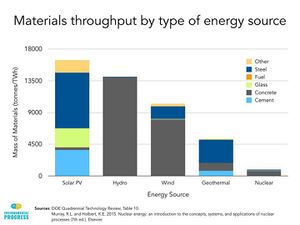Electric Grid
Published: January 5, 2022
Author: C. Michael Hogan
Topic Editor: Dawn Wright
| Topics: |
An electric grid is a network of hardware and software that serves to deliver power from its generation source to the ultimate consumer. Alternatively termed electrical grid or electric power grid, such a network may encompass a large geographic area, such as an entire nation. Most commonly, grids use three-phase alternating current. (Stevenson, 1975) Grid integrity is receiving increased scrutiny in recent years, because political rather than engineering-based decisions are often made in a rush to promote certain types of energy generation; (Knight, 2001) in places such as Germany and California, the result has been to provide an inadequate electrical base load and produce more frequent blackouts. (Starn et al, 2021)
Contents
Grid Components
The main elements of an electric grid are:
- Power plants: which produce electric power from primary sources such as wind, natural gas, geothermal, nuclear, and solar
- Transmission lines: which convey electricity across often considerable distances
- Substations: which are used to step up or step-down voltage
- Storage: which chiefly consist of expensive battery storage or hydroelectric storage of water behind a dam
- Distribution systems: which typically step-down voltage and deliver to end users.
A grid can typically accommodate multiple power plants of different types of power generation sources. Transmission lines can consist of different voltages and load ratings. There are significant power losses that occur in transmission lines. For example, with a 345-kilovolt line carrying a one-megawatt load, there is about 4.2% loss per 100 miles. (Baylor, 2007) Substations and distribution systems are quite variable in components depending upon service areas and scale.
Grid Integrity
It is vital that an electric grid be reliable, since millions of people may depend on a given grid. The biggest threats to grid reliability are lack of adequate base load and cyber security threats. (Douris, 2018) Grid integrity in many locales has deteriorated in many regions, chiefly because of political decisions to reduce base load in favor of expanding intermittent power sources such as solar, wind and tidal. Inadequate base load can also lead to blackouts and other adverse consequences such as increased wildfire risk. For example, wildfires in Sonoma, Napa and Butte Counties, California have been shown to be the responsibility of PGE, a major electric utility. These wildfires stemmed from inadequate vegetation clearance near transmission lines and transformers; however, some of the fires had a contributory cause of low base load. When low base load conditions prevail (usually at nignt) grid managers may make a decision to use repetitive sparking of downed transformers, known as reclosure programming, in order to minimize chances of a widespread blackout. This repeated sparking was a cause of several of the Napa and Sonoma County wildfires.
Transmission Line Loss
Most modern grids are comprised by massive agglomerations of land; for example, most of the western USA consists of a single grid. This scale has the advantage of allowing supplemental power to be wheeled into an area requiring power; however, line losses can be severe. California, for example, suffers from persistent low baseloads; If power is moved from the abundant dependable coal fired plants in the Four Corners to coastal California, the wheeling loss is about 26 percent. This magnitude of power loss is a strong argument to avoid driving an electric vehicle, since electric vehicle carbon efficiency already trails a hybrid vehicle.
Failure Modes
Most grid failures are linked with generators or transmission lines tripping circuit breakers; many of these failures stem from a user demand exceeding available grid load. A major failure can cause current to re-route, often via transmission lines of insufficient capacity, cascading into further failures and a widespread power outage. (ZhaI, 2017) In the USA, the North American Electric Reliability Corporation has powers to address such issues. It should be noted that overhead transmission lines are much more prone to failure or downage than below ground counterparts; also, overhead lines are much more likely to be the cause of wildfires, particularly in situations of marginal base load.
Energy and Material Costs of the Grid
Obviously, the energy and material costs of creating an electric grid are quite large. The quantities of energy, hence carbon emissions of manufacture vary considerably by power source type as shown in the graph at the right. Solar farms clearly are the most carbon intensive sources of power in the manufacturing stage of component life cycle, with nuclear being the lowest carbon footprint; not shown in the graph is material cost of natural gas plants, which value is intermediate among the sources. Note that nuclear fusion power is an extremely promising virtually zero carbon footprint process, which is in the early commercial feasibility stage of development.
References
- Baylor University (2007) American Electric Power Transmission Facts.
- Douris, Constance. As Cyber Threats To The Electric Grid Rise, Utilities And Regulators Seek Solutions. Forbes. Retrieved 2018-09-27.
- Knight, U.G. Power Systems in Emergencies - From Contingency Planning to Crisis Management John Wiley & Sons 2001 ISBN 978-0-471-49016-6 section 7.5 The 'Black Start' Situation
- Jesper Starn, Brian Parkin & Irina Vilcu (2021) The Day Europe’s Power Grid Came Close to a Massive Blackout. Bloomberg News
- William D. Stevenson, Jr. Elements of Power System Analysis Third Edition, McGraw-Hill, New York (1975). ISBN 0-07-061285-4
- Zhai, Chao (2017). Modeling and Identification of Worst-Case Cascading Failures in Power Systems. arXiv:1703.05232 [cs.SY].
Citation
C. Michael Hogan (2022) Electric Grid. ed. D. Wright. Encyclopedia of Earth. National Council for Science and Environment. Washington DC.


